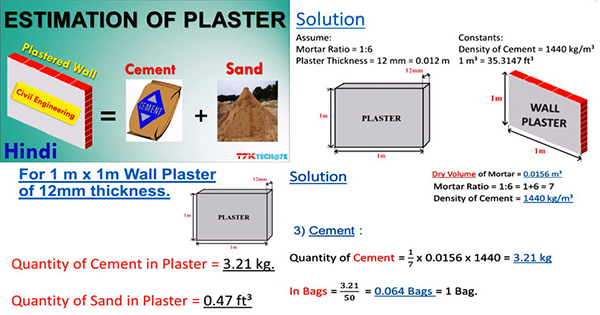How to find out the quantity of cement and sand for plastering a wall

This construction video tutorial is based on how to quantify the amount of cement and sand necessary in a plastering work for wall.
In this video, proportion of mortar is taken as 1:6 (1 for cement and 6 for sand)
The density of plaster is taken as 12 mm or 0.012 m
Given below, the approved density of plaster:-
- 12 mm – It is ideal for plain surface of brick wall or for interior walls
- 15 mm – It is suitable for rough surface of 9” or 4” brick wall
- 20 mm – It is perfect for two layer of plaster generally utilized for outside walls
The following constants are selected for the work:-
- Density of cement = 1440 kg/m3
- 1m3 = 35.3147 ft3
- The dimension of the wall is 1 meter x 1 meter and the plastering will be done on this wall.
- Initially, it is necessary to find out the volume of Mortar = 1 x 1 x 0.12 (length x breadth x density) = 0.012 m3
Now, weight volume should be converted to dry volume as follow:-
- 0.012 x 1.30 = 0.0156 m3
- It is multiplied with 1.30 as dry volume for mortar (cement and sand) is equivalent to 30 to 35% in excess of wet volume i.e. 1.30 x wet volume.
- For concrete work (cement + sand + aggregate) dry volume is equivalent to 1.54 x wet volume.
Now, find out the quantity of cement as follow:-
- Quantity of cement = 1/7 x 0.0156 x 1440 (one part cement x density of dry volume x density of cement) = 3.21 kg
Now, convert the quantity to bags:-
- 3.21/50 = 0.064 bags = 1 bags (weight of 1 bag = 50 kg)
Now, find out the quantity of sand as follow:-
- Quantity of sand = 6/7 x 0.0156 (ratio of sand x dry volume) = 0.0133m3
- To convert it to cubic feet = 0.0133 x 35.3147 = 0.47 ft3
To get more clear conception, watch the following video tutorial.
Video Courtesy : TECH@7K

